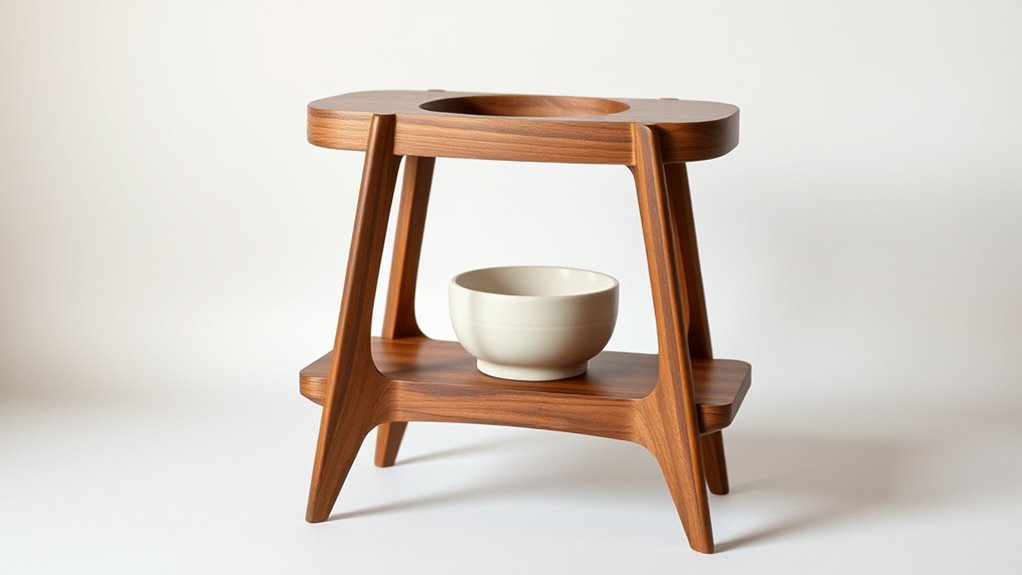To craft a mid-century modern plant stand from a single board, start by selecting a high-quality, sturdy wood like walnut or oak. Cut and shape the board into a sleek rectangular top, then design simple, geometric legs that attach at each corner for stability. Sand all edges smoothly and finish with a natural oil to highlight the grain. Focus on clean lines and proportions for a timeless look. If you keep going, you’ll discover more tips for perfecting your design.
Key Takeaways
- Select a high-quality, sturdy wood board large enough for the stand’s dimensions.
- Cut and shape the board with precision, creating a sleek surface and minimalistic form.
- Design and attach geometric legs or supports at each corner for stability and aesthetic balance.
- Sand edges smoothly and apply a natural oil or matte finish to enhance grain and protect the wood.
- Ensure all joints are secure, and the final piece is stable, functional, and complements mid-century modern decor.

If you’re looking to elevate your indoor greenery, crafting a mid-century modern plant stand is a stylish and functional choice. This project combines clean lines, minimalism, and a touch of vintage charm, making it a perfect addition to any interior. To get started, you’ll want to draw on design inspiration that emphasizes simplicity and natural materials. Look at iconic mid-century furniture for ideas on proportions and details, and think about how your plant stand can serve as both a decorative piece and a practical support for your plants. The key is to keep it sleek, with a focus on form and function.
Create a sleek, vintage-inspired plant stand that blends form and function with natural materials.
When it comes to woodworking techniques, working with a single board requires precision and attention to detail. You’ll start by selecting a sturdy, high-quality piece of wood—preferably walnut, oak, or pine—that’s large enough to accommodate your design. Using basic tools like a saw, drill, and sandpaper, you can shape the board into a stylish stand without complex joints or multiple pieces. Cut the board to your desired dimensions, keeping in mind the height and width that will best showcase your plants. Sand the edges smoothly to achieve that polished, mid-century look.
Next, focus on creating stability and a balanced aesthetic. You might cut out simple geometric legs from the same board or attach additional supports to elevate the stand. If you opt for legs, cut four equal pieces and attach them at each corner with wood glue and screws, ensuring everything lines up perfectly. This approach not only enhances the visual appeal but also maintains the integrity of the single-board design, emphasizing minimalism. Incorporate a stable base to improve overall support and safety for your plants. Don’t forget to drill small holes or slots if you plan to add decorative elements or additional support features.
Finishing touches are critical—apply a natural oil or matte finish to protect the wood and bring out its grain, aligning with the warm, organic feel typical of mid-century modern style. This step also helps to smooth out the surface and makes the stand more durable. Once assembled and finished, your handmade plant stand will serve as a stunning focal point that complements your plants and interior décor. With a blend of thoughtful design inspiration and proven woodworking techniques, you’ll craft a piece that’s both timeless and uniquely yours—proof that simplicity and craftsmanship can create truly striking home accents.
Frequently Asked Questions
Can I Customize the Size of the Plant Stand?
Yes, you can customize the size of your plant stand. By adjusting the dimensions during the design process, you can create size adjustments that suit your space and plant size. This allows for aesthetic variations, making your stand unique and tailored to your style. Just guarantee you maintain structural stability while resizing, so your plant stand remains functional and visually appealing. Customizing size helps you achieve the perfect look and fit.
What Types of Wood Are Best for This Project?
You should choose woods like teak, cedar, or cypress for this project because they have attractive wood grain and offer excellent moisture resistance. These qualities help your plant stand stay durable and look stylish over time. Avoid softer woods that might warp or deteriorate quickly. Picking the right wood guarantees your stand is sturdy, weather-resistant, and visually appealing, perfect for showcasing your plants in a Mid-Century Modern style.
Is Special Finishing or Sealing Required?
Think of your plant stand as a mini fortress, protecting your greenery. You’ll want a good wood finish to enhance its beauty and durability. Sealing techniques like polyurethane or oil finishes act like armor, shielding against moisture and scratches. No special sealing is necessary, but applying a quality finish ensures your stand stays sleek and sturdy over time. Just follow the product instructions for a smooth, lasting result.
How Much Time Does the Entire Process Take?
The entire process, from wood selection to finishing, usually takes around 2 to 4 hours depending on your experience. You’ll need time to choose the right wood, which impacts finish options, and to assemble and sand the plant stand. If you opt for a special finish or sealant, add extra time for drying. Overall, plan for a relaxed project that allows patience with each step for a professional look.
Can I Adapt This Design for Larger Plants?
Imagine you want to hold a larger plant, like a tall fiddle leaf fig. You can adapt this design by using scaling techniques—making the base wider and thicker—and considering weight considerations to guarantee stability. Strengthen joints and select sturdier materials if needed. With careful adjustments, you’ll create a functional, stylish stand that supports bigger plants without compromising the mid-century modern aesthetic.
Conclusion
Now that you’ve assembled your sleek plant stand, imagine the statement it’ll make in your space. But wait—there’s one final detail that could elevate it even more. Are you ready to add that perfect finishing touch? With a little extra flair, your mid-century modern piece will not only showcase your plants but also become a enthralling conversation starter. Stay tuned—what comes next might just be the secret to truly making it yours.









